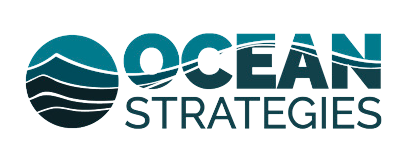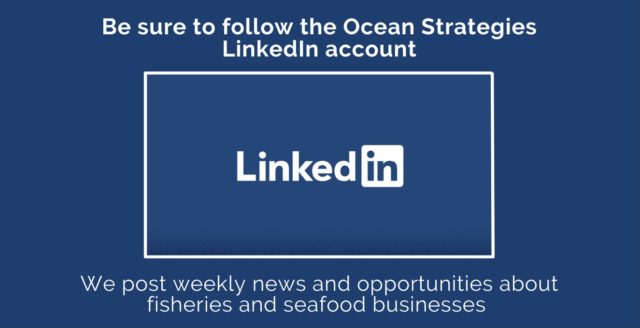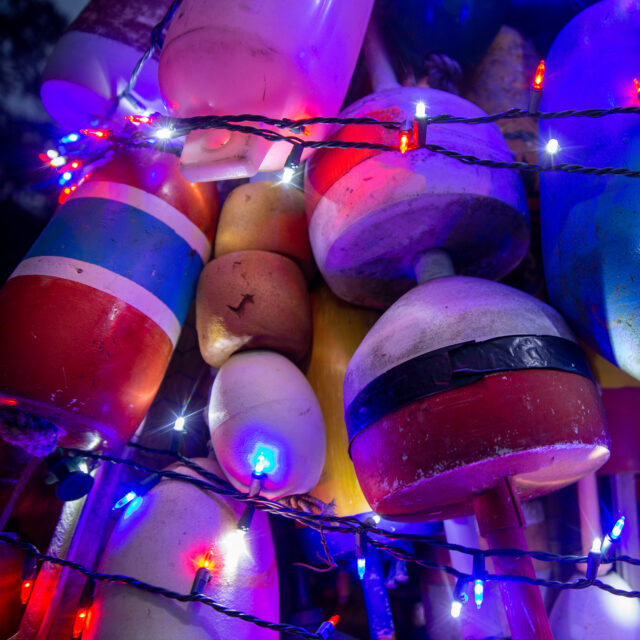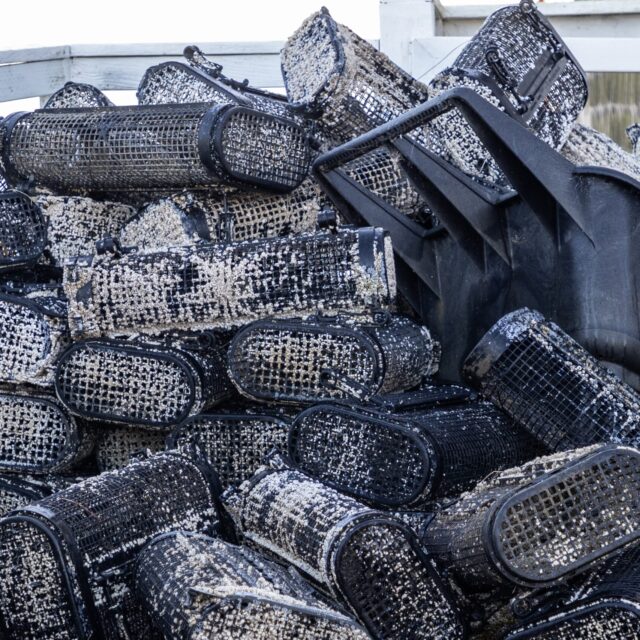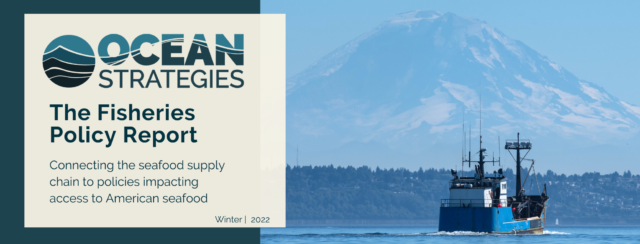
The Ocean Strategies Fisheries Policy Report provides timely policy and industry updates that connect America’s sustainable seafood supply chain — including grocers, restaurants, distributors, transportation and the many other businesses that depend upon seafood access.
Not already signed-up? Receive future updates by signing up.
WHAT WE’RE WATCHING IN FEDERAL FISHERIES POLICY
Fisheries Provisions in America COMPETES Act Get Mixed Reception from Seafood Businesses
The House of Representatives passed a $350 billion spending bill earlier this month, aimed at upping America’s ability to compete in global trade. The America Creating Opportunities for Manufacturing, Pre-Eminence in Technology, and Economic Strength Act of 2022 addresses national and economic security issues. It authorizes billions of dollars to boost domestic technology research, critical supply chains, and science, technology, engineering, and mathematics (STEM) education and training.
Seafood Concerns: The Act includes a variety of fisheries provisions, including expansion of the Seafood Import Monitoring Program (SIMP) to include all seafood and seafood products imported into the U.S. This initially received a cool reception from America’s seafood businesses, many of whom were concerned that failure to implement SIMP iteratively would result in massive supply chain disruptions. Wrote one group of concerned businesses: “These provisions would also expand SIMP down the entire supply chain “to the point of final sale” (including individual packages, and menus)—thus imposing a blizzard of paperwork and insurmountable compliance burdens on processors, distributors, restaurants, and grocery stores that supply millions of seafood meals to American families…They will impose requirements on seafood companies so complex that much of the supply chain is likely to grind to a halt in response.”
Lawmakers ultimately dropped the sections requiring traceability through the entire supply chain, but kept the requirement of traceability until import.
- Expansion of Illegal, Unreported and Unregulated (IUU) fishing identification through data from non-governmental stakeholders, the public, and SIMP.
- Expansion of U.S. authority to revoke port privileges for fishing vessels from nations identified for IUU fishing.
- Buy American Seafood provision: Establishes that when the federal government purchases seafood, they should prioritize buying seafood caught or harvested in the U.S. Also authorizes the Sec. of Commerce to use S-K grant funds to promote the consumption of domestic, climate friendly, invasive, or well-managed but less known species.
- A comprehensive study into offshore aquaculture including the environmental impact, identification of control technologies and practices to minimize environmental impacts, and assessment on the impact of international offshore aquaculture industries on the US seafood market.
- H.R. 404 Driftnet Modernization and Bycatch Reduction Act: Phase-out of large-scale driftnet fishing (mesh size 14” or larger) in the EEZ over the next five years.
- H.R. 2188 Shark Fin Sales Elimination Act
What’s Next: The Senate and the House will sort out the differences in their two bills in conference. Once a compromise bill is reached, both chambers must vote again, before it heads to the White House for Biden’s signature. This process is expected to be tough, as House Republicans say the legislation isn’t tough enough on China and that the Green New Deal initiatives included go too far.
______________________
References
30×30 public comment period
Seafood dependent businesses asking Biden Administration to prioritize a robust sustainable seafood supply within conservation effort
The Biden-Harris administration is seeking broad public comment on its sweeping climate-focused initiative. The Executive Order on Tackling the Climate Crisis at Home and Abroad was signed in late January 2021 and ambitiously addresses the growing impacts of climate change.
In a first step toward meeting that order, a multi-agency report released in May 2021 (Conserving and Restoring America the Beautiful) outlined major conservation initiatives that include 30×30, an effort to conserve and restore 30% of our nation’s lands and waters by the year 2030. This has sparked concern from seafood producers, who hope to see sustainable seafood as a partner in conservation, not a casualty of it.
In December 2021, the U.S. Department of the Interior (DOI) released its first annual progress report on the America the Beautiful initiative, summarizing all of the inter-agency work that was pursued throughout 2021.
Now, after a series of public listening sessions held last month, DOI is asking for public input specific to the development of the American Conservation and Stewardship Atlas, a tool that will serve as a baseline inventory of ocean and terrestrial conservation measures. The agency is requesting feedback on what areas should be included in the Atlas.
Specific information that DOI is focused on includes:
- Science and Data. What data sources, standards, and technical approaches should be applied to data included in the Atlas to ensure that it is an authoritative and useful tool for the public?
- Conservation as a Continuum. How can the Atlas reflect the meaningful conservation work already underway in America?
- Outcomes. How can the Atlas best reflect land and water contributions to biodiversity, climate change mitigation and resilience, and equitable access to nature and its benefits?
Seafood industry stakeholders have been actively providing input on the federal government’s role in communicating the success of U.S fisheries management. Maintaining a sustainable seafood economy and protecting fishing communities are vital as the administration works toward meeting 30×30’s goals.
Seafood- and fisheries-dependent businesses are strongly encouraged to submit comments. More information can be found on the Federal Register Notice and comments may be submitted here. The deadline to provide input is Monday, March 7, 2022.
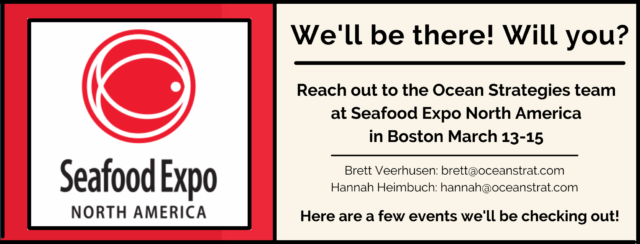
SENA Highlights
The sharpest people in seafood are speaking at this year’s SENA conference. We’re most excited about these compelling events, we hope to see you there!
Sunday, March 13th
- WHY SEAFOOD QUALITY IS CRITICAL: FROM THE FISHERMEN TO THE SUPERMARKET AND CHEF, AND HOW TO DELIVER IT, 1:00 PM – 2:00 PM
- SEAFOOD TRENDS AND PREFERENCES IN FOODSERVICE MOVING FORWARD
1:00 PM – 2:00 PM - NOAA’S PLANS TO ENSURE RESILIENT MARINE FISHERIES AND STRENGTHEN THE U.S. SEAFOOD INDUSTRY, 3:30 PM – 5:00 PM
- FINDING THE NEXT GENERATION OF DIVERSE SEAFOOD TALENT, 3:30 PM – 5:00 PM
Monday, March 14th
-
PLENARY: 3 WAYS TO INCORPORATE A DIVERSITY AND INCLUSION PROGRAM TO BENEFIT YOUR BUSINESS, 10:30 AM – 11:30 AM
-
MOVING FROM TRACEABILITY TO TRANSPARENCY: DIVERSE STAKEHOLDERS DRIVING SEAFOOD TRANSPARENCY EXPANSION, 11:45 AM – 12:45 PM
-
TRANSFORMING AQUACULTURE: THE FUTURE OF SEAFOOD MUST INCLUDE INNOVATION, 11:45 AM – 12:45 PM
-
RAS PROJECT DEVELOPMENT IN THE UNITED STATES, 1:30 PM – 2:30 PM
-
FMI POWER OF SEAFOOD 2022: CONSUMER INSIGHTS INTO HOW AND WHY THEY SHOP SEAFOOD, 1:30 PM – 2:30 PM
-
UNITE THE INDUSTRY & CREATION OF A NATIONAL SEAFOOD MARKETING CAMPAIGN
1:30 PM – 2:30 PM -
HOW DO WE CAPITALIZE ON ENVIRONMENTAL AWARENESS TO ACCELERATE GROWTH ON THE HEELS OF THE GLOBAL COVID PANDEMIC?, 2:45 PM – 3:45 PM
- HOW DO MILLENNIALS MAKE THEIR PURCHASING DECISIONS?, 4:00 PM – 5:00 PM
Tuesday, March 15th
- MORE IF BY SEA… GETTING AMERICANS TO EAT FISH AND SEAFOOD MORE FREQUENTLY, 10:00 AM – 11:00 AM
- INTEGRATING SEAFOOD PLASTIC AND CARBON ACTION PLANS FOR A SMARTER SEAFOOD SECTOR AND BETTER ENVIRONMENT AND CLIMATE, 11:15 AM – 12:15 PM
The Ocean Strategies team invites readers to meet our partners and industry colleagues at these booths:
- Bristol Bay Seafood Development Association, Booth #2742
- Alaska Seafood Marketing Institute, Booth #1633, 1739
- Penn Cove Shellfish, Booth #919
- Fortune Fish & Gourmet (Fortune Imports), Booth #1433
- OBI Seafoods, Booth #1205
- Seattle Marine Fishing Supply, Booth #689
- NOAA Fisheries, Booth #189
- Global Seafood Alliance, Booth #481
OP-ED: SEAFOODSOURCE
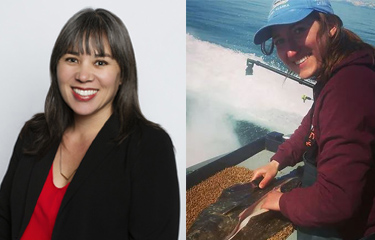
Sustainable fishing regulations must move faster
By Teresa Ish & Marissa Wilson
The following is an op-ed published by SeafoodSource.com on Feb. 7, 2022. Teresa Ish is the senior program officer and oceans initiative lead at the Walton Family Foundation and Marissa Wilson is the executive director of the Alaska Marine Conservation Council.
As climate change has increased its impact on our planet’s oceans, uncertainty has become the new normal. Warmer waters are causing fish to migrate to new environments to stay within their natural range, or to follow shifting sources of food. As the amount of carbon dioxide in our atmosphere rises, the ocean is becoming increasingly acidic, threatening the conditions necessary for all marine life to survive.
These changes are not only causing major disruptions to life within our oceans; they are also impacting the lives and livelihoods of people and communities who depend on healthy and sustainable marine ecosystems for food and commerce. In short, as the climate is changing, the laws and regulations that we use to protect both the fish in the ocean – as well as the fishers who rely on them – have to change as well.
Seafood matters locally, and beyond. Globally, more than 60 million people are employed by the seafood industry. In addition, more than three billion people around the world rely on fish for a significant source of protein.
Photos Provided by Authors
OCEAN STRATEGIES MEDIA
Ocean Strategies is proud to participate in seafood dialogues across the country, bringing our boots-on-deck perspective to local-to-global seafood movements. We launched the brand new Ocean Strategies website last fall and its blog: Ocean Pulse. We also stay connected to our colleagues through LinkedIn. Check out the link below to learn more.
INDUSTRY LOGBOOK
Q & A with Leigh Habegger
Ocean Strategies recently chatted with Leigh Habegger, Executive Director of Seafood Harvesters of America, a national commercial fishing organization that works to advance science-based policies and regulations that support sustainable fisheries. Leigh discussed federal seafood-related legislation, how the commercial fishing industry has overcome Covid-19 challenges, and the important role restaurants play in our seafood supply chain.
Click the image above to watch and listen to the full interview with Leigh Habegger and Ocean Strategies Principal Brett Veerhusen. To read the full text of the interview click here.
Be sure to check out the Seafood Harvesters op-ed in The Hill, “How a continuing resolution will impact the next generation of commercial fishermen,” urging Congress to fund the Young Fishermen’s Development Act.
Brett: Leigh, thanks so much for joining us today. As commercial fishermen ourselves, we’re looking forward to getting into some fishing-related policies and issues you’ve been working on lately. But we like to start with the tough questions first – what is your favorite seafood to eat, and how do you prepare it?
Leigh: I think I’m going to have to stay true to my Southeastern roots and go with flounder. I love to cook it in a pan with a little bit of butter, garlic, lemon juice, and salt and pepper. But I’ll also say that it is hard to beat a fried flounder sandwich after a day on the boat. When I was up in Alaska a couple years ago I had the best salmon salad of my life. It was so simple, so fresh, and just delicious. It’s hard to beat fresh Alaskan salmon!
Brett: Some of the best salmon you can have is the simplest! So let’s get into fisheries policy and talk about the cornerstone of U.S. federal fisheries management – the Magnuson-Stevens Act. Last year Congressman Jared Huffman introduced the Sustaining America’s Fisheries for the Future Act, a bill that would reauthorize MSA. What proposed MSA updates are Seafood Harvesters tracking?
Leigh: First, I think it’s important to remember that amid all these reauthorization efforts, Magnuson is working. Any changes to our overarching federal fisheries law should not undermine the strides and advancements that have already been made, thanks to MSA. It’s critically important for seafood industry stakeholders to be aware of the MSA reauthorization discussion and to engage with their members of Congress. There is a long list of changes that Rep. Huffman is proposing, and it could impact the seafood industry in a variety of ways. I would encourage fishermen and other folks throughout the seafood supply chain to take a look at the bill. Review the proposed changes, and if you see something that’s going to impact your operations, then get involved and provide feedback. Mr. Huffman has been very open and willing to hear from all corners of the seafood industry. It’s a great opportunity.
Brett: Seafood Harvesters of America has been leading the fishing industry nationwide by advocating for relief funds and effective policies related to Covid-19. I know you were active on the Restaurants Act – restaurants being a critical component of who we supply and sell our seafood to. What are things looking like, pandemic-wise, for fisheries and the supply chain now that we’re getting closer to some busy summer fishing seasons?
Leigh: Two years into the pandemic, and the fishing industry has learned to adapt. We’ve learned how to stay safe and keep our crew and people who work in processing plants safe. We’ve figured out how to get back to doing what we love, which is fishing. The Covid relief funding that was appropriated by Congress thanks to the CARES Act and then in an appropriations bill at the end of 2022, was incredibly helpful. It allowed us to make those adaptations to our operations.
On the restaurant side of things, we need our restaurants. We love them and we want them to succeed. The Restaurant Revitalization Fund is an initiative that the Independent Restaurant Coalition has been leading on. It’s an important program and was critical to helping restaurants get back on their feet. Many Americans and people around the world enjoy their seafood at restaurants. They play an important role in seafood access for consumers.
Brett: There’s a lot of legislation moving at the federal level that could impact the seafood industry. What policies does Seafood Harvesters feel are most critical to be weighing in on?
Leigh: First, there’s an opportunity to weigh in on the 30×30 initiative. The comment period deadline to provide input on the Marine Protected Area Atlas is March 7th. NOAA and the Department of Interior want to hear from stakeholders about what existing conservation areas, both marine and terrestrial, should be included in the Atlas as they figure out their inventory of conservation measures. Harvesters supports the existing work of the fishery councils, and the important conservation measures and protections they have already put in place. Councils need to be at the heart of this 30×30 effort. They have the expertise and institutional knowledge on fisheries management. This initiative has the potential to be good for ocean health and complement the commercial fishing industry; it doesn’t have to be one or the other.
There is also an ongoing opportunity for stakeholders to weigh in on the annual federal appropriations process; this is an important area to advocate for funding that would benefit the seafood industry. It is critical that NOAA programs receive robust funding so important parts of their mission can continue.
Brett: The Aquaculture Opportunity Area (AOA) process has been very robust.The level of thoroughness and detail in NOAA’s roadmap for potential sites for aquaculture operations is impressive. Do you agree with NOAA’s conclusions regarding the two AOAs they have already identified?
Leigh: NOAA identified these AOAs as areas where offshore aquaculture could reasonably coexist with minimal conflict with other uses, whether that be military, fishing, shipping, or protected areas. It’s important to note that AOA’s do not permit aquaculture, they are just a siting exercise. This is a thorough process, and it was clear that the commercial fishing industry was being heard, as changes were made to reflect our input.
You know, aquaculture may make sense in some areas but not others. Fishermen may want to use it as a way to diversify their fishing portfolio, but that might not work in other areas. There’s also an opportunity here to tackle the issue of working waterfronts. We could think of aquaculture development as a way to preserve and build back some lost waterfront infrastructure – processing capabilities, ice houses, fuel docks, marinas. I think there is a way for all of this to coexist.
Brett: I want to finish with one question – what have you learned as a female leader within the next generation of fisheries policy experts, and what advice do you have for others who are working in the industry or hoping to get involved?
Leigh: I’ve thoroughly enjoyed my time working in fisheries policy and in particular working for the commercial fishing industry. It’s a welcoming community of men and women who are excited to see a younger crowd with a passion for fisheries get involved. I feel lucky that I get to get up and do this everyday.
My advice would be – you get out what you put in. I have worked hard to learn the history of fisheries policy and that’s an important context to have as we look forward to addressing these issues. And making connections is vital. Fishermen are willing to pass along their institutional knowledge because they want young people to get involved, they know we can help retain their access to go fishing.
Brett: Very well said. You can’t catch fish with your net out of the water, and similarly as a policy expert working in fisheries, you get out what you put in. It does take that hard work and grit. Leigh, thank you so much for your time. It’s been an honor speaking with you.
